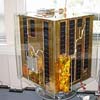| . |  |
. |
Next month should see the launch of the first Galileo satellite which will be paving the way for Europe's global positioning service. The GSTB-V2A spacecraft has been built by Surrey Satellite Technology (SSTL) in the UK, a company which was created in 1980. Euronews has been to visit the former university students who pioneered the use of small satellites. "My interest in satellites started during the Apollo era in 1969," remembers Professor Martin Sweeting, today Chief Executive Officer of SSTL. "I was watching that just before I went to university." The University of Surrey in Guilford, 50 km from London, was to be the springboard for a spin-off company which now employs 250 people. "In 1985 everybody was building bigger and bigger satellites and we were saying the contrary: smaller and smaller," recalls Sweeting. "People were saying it was an interesting but crazy idea with no future. But over the last 20 years, small satellites have offered a more flexible and economical way of getting to space. Today small satellites are a fashionable activity, and a major part of the space scene." SSTL has been involved in over twenty different projects. Many of the first spacecraft built at Surrey were for amateur radio enthusiasts. But over the years, the company attracted a wide field of users, from Earth observation for countries without the financial resources to have conventional satellites, to specific civilian or military applications on demonstrator missions for major powers. To bring down production costs and to cater for its clients� requirements, SSTL resorted to industrial techniques and materials used in the car industry or in computing � the COTS (Commercial off The Shelf) approach. SSTL's reputation worldwide led to its selection by the European Space Agency to provide one of the two first satellites for the Galileo constellation. "After we developed the 300 kg mini satellites, which was really stretching our capabilities upwards, we realised that we could respond to the ESA call, taking that platform, developing it a bit further and putting on some of the Galileo payload. It would offer a very low cost alternative to the conventional way of doing things."
Its final destination will be a 23,000 km orbit around the Earth. The satellite will validate new critical technologies and will transmit an experimental signal on radio frequencies attributed by the International Telecommunications Union. Galileo, to be fully deployed by 2008, will eventually have a 30-strong constellation of satellites in three orbital planes. It will be interoperable with the US GPS and the Russian Glonass systems but with a highly accurate 1-metre precision, so far only attainable with military systems. Galileo signals will offer numerous civil applications � an estimated market of 1.8 billion users in all sectors of daily life. The most obvious will be localisation of, and two-way communication with, mobiles. Road vehicles, ships and aircraft will be able to navigate with greater precision and in areas where no terrestrial aids are available. "The challenge for us was to design and manufacture GSTB-V2/A, a quite sophisticated spacecraft, in a very short period of time," says John Paffet, development project manager at SSTL. "In approximately 27 months we have gone from a concept stage, then the design, the manufacturing, tests and the integration stages for the launch next month." SSTL prides itself on the rapidity of development and reliability of its products. However, Martin Sweeting recognises that the company's approach still has to overcome certain reticences. "In order to have low cost and rapid response, we have to adopt a much more industrial system, more akin to the information technology industry. It is difficult for large space agencies to change their mind set to actually use small satellites, the laptops of space, as opposed to the main frame computers of space." Related Links Galileo SSTL - GSTB-V2A SpaceDaily Search SpaceDaily Subscribe To SpaceDaily Express  Paris (ESA) Nov 01, 2005
Paris (ESA) Nov 01, 2005Since Friday morning, the ground control station in Aalborg has not had any contact with SSETI Express. Thorough analysis over the weekend indicates that a failure in the electrical power system on board the spacecraft is preventing the batteries from charging, resulting in a shutdown of the satellite.
|
| |||||||||||
| The content herein, unless otherwise known to be public domain, are Copyright 1995-2016 - Space Media Network. All websites are published in Australia and are solely subject to Australian law and governed by Fair Use principals for news reporting and research purposes. AFP, UPI and IANS news wire stories are copyright Agence France-Presse, United Press International and Indo-Asia News Service. ESA news reports are copyright European Space Agency. All NASA sourced material is public domain. Additional copyrights may apply in whole or part to other bona fide parties. Advertising does not imply endorsement, agreement or approval of any opinions, statements or information provided by Space Media Network on any Web page published or hosted by Space Media Network. Privacy Statement All images and articles appearing on Space Media Network have been edited or digitally altered in some way. Any requests to remove copyright material will be acted upon in a timely and appropriate manner. Any attempt to extort money from Space Media Network will be ignored and reported to Australian Law Enforcement Agencies as a potential case of financial fraud involving the use of a telephonic carriage device or postal service. |